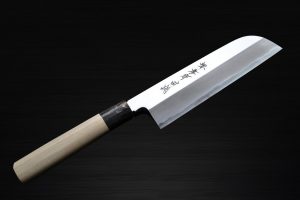Do I Really Need a Yanagiba or Sashimi Knife to Make Good Sushi and Sashimi?

A Japanese knife is definitely an essential cutlery, a magical tool needed by all Japanese food chefs to successfully craft their very own idealistic, authentic and traditional Japanese delicacies. Especially when it comes to sushi and sashimi dishes, culinary professionals would have to be more attentive to details, as the preparation processes are intricate than those of other general dishes. With this being one of the reasons why Japanese cuisine has earned its fame and popularity for decades and still is up in the charts without a slight hint of stepping down from its success, diners and gourmets are well aware that the components behind all the beautiful aesthetics, the delightful tastes, and the delicate flavors include the help of a Japanese knife.
A Japanese knife is different from that of a general knife found in home kitchens. One thing that truly makes traditional Japanese knives different from the common, Western ones is the fact that many Japanese knives are honed only on one side. However, for left-handed users, there are Japanese knife brands that offer a wide variety of knife types and specifications catering to the needs and preferences of users. A Japanese knife is special; it is often used to craft delicate dishes like sushi and sashimi as the single sided honing feature enables chefs to create the sharpest edge possible. Japanese knives are forged to have extremely sharp edges and surprisingly hard blade bodies. The level of sharpness is more than what can be accomplished with a common Western style knife which is honed equally on both sides – often called ‘double edge knives’.
Due to supreme-quality materials and traditional techniques required to hand-craft a perfect Japanese knife, many knife users might believe these cutleries are extremely high in price. However, as professionals and culinary experts are the ones who know best, distinguishing between a knife for professional-use and a normal knife for simple cooking routines is not at all a hard task. When a question upon the necessity of a Japanese knife is brought in a table full of culinary experts, everyone would say the same thing: a sushi chef needs at least one blade companion, and that blade should be a Japanese knife.
As a sushi enthusiast or a Japanese food aspiring chef, knowing why a sushi or sashimi knife is needed will be the primary step to greatly understand the basic concepts of Japanese cuisine. First of all, a Japanese knife, specifically a Yanagiba or a sashimi knife, is narrow and long in shape. For the best slicing, filleting, boning, and cutting experience, a sashimi knife is needed by chefs to perfectly and accurately slice through a wide variety of meat types and fresh, hand-picked seafood delicacies. A kitchen knife might find its way through the thick layers of flesh, but the results may depict wriggly lines of unprofessionalism. A Japanese knife, on the other hand, is designed to be light in weight, yet strong, durable, and sturdy enough to slice through various materials and fine ingredients. A sushi knife especially made and designed to have high edge retention and stain resistance is also absolutely a much better choice compared to general kitchen knives that are always ready to rust just after a few uses. Designed with the Japanese traditions and culture in mind, most Japanese knives are simple, yet elegant. The materials that make up the blade and the handle are always hand-picked and wisely selected by professional blacksmiths and highly-skilled craftsmen.
With all this being said, there is always a reason to why Japanese knives are higher in price when compared to general kitchen knives. As a specific kind of knife used for the crafting of Japanese delicacies, it cannot be denied that Japanese food chefs are always in the search for just the best blades.


